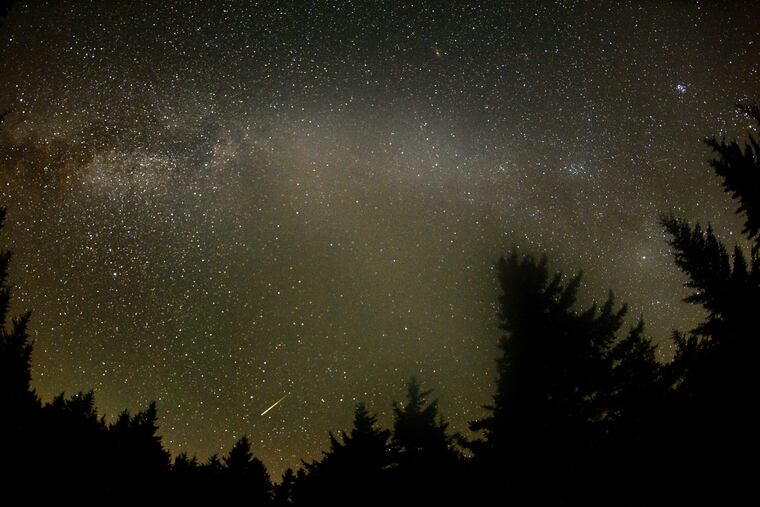Meteor shower drought ends as Lyrids peak Tuesday night into Wednesday morning
At the peak, as many as 20 meteors or more might streak across the night sky.

The Lyrids, among the oldest observed annual meteor showers, are due to peak late Tuesday and early Wednesday, and viewing conditions might be ideal as skies are due to clear nicely.
And the lunar influence will be negligible. The visible arc of the slivery new moon, which will be at less than 2% illumination, will be barely wider than a meteor streak, which essentially is falling cosmic debris made incandescent by the atmosphere.
» READ MORE: Orionid meteor showers are stars of night sky — and YouTube
The Lyrids have a reputation for speed and brightness, according to veteran sky watchers, and at their peak, as many as 20 will be streaking across the sky an hour.
Where to look
The Lyrids earn their name because they appear to radiate from the constellation Lyra — Latin for “lyre,” or harp — but you’re liable to see them anywhere in the sky.
NASA is advising viewing away from the radiant, which would be toward the northeast. “They will appear longer and more spectacular from this perspective. If you do look directly at the radiant, you will find that the meteors will be short — this is an effect of perspective called foreshortening,” the agency says.
Of course, the best viewing would be under a perfectly dark sky free from light interference, which can be tough to find around here, where so much light gets thrown to the sky.
» READ MORE: Stargazing around Philadelphia: Everything you need to know
In any event, the best viewing would be in clearings away from tall buildings and trees.
The optimal view time would be Tuesday toward midnight, and during the early morning hours Wednesday.
Meteors still could be visible in subsequent nights, although not quite as many.
What will one see
Do not expect fireworks.
Meteors usually appear as evanescent streaks, although on occasion a larger piece of material descending toward the Earth will appear to explode into a greenish fireball.
But do expect a dash of celestial history. The Lyrids first were observed by the Chinese in 687 B.C., making them among the oldest of observed celestial phenomena.
Otherwise, meteors constitute a subtle pleasure that some might find downright disappointing unless they are the types who like to muse over the origins of the universe.
What are these things
They are the remnants of washed-up comets.
Debris from various broken-up asteroids are doomed to prowl the solar system, and annually the Earth’s orbit passes through their remnants.
The Lyrids are believed to be the leftovers of the comet C/1861 G1 Thatcher, discovered in 1861 by one A.E. Thatcher.
The Lyrids end a three-month hiatus of major meteor showers.
The most prolific of the annual shows is orchestrated by the Perseids, which occur in August. At their peaks, 50 meteors an hour can streak across the sky.
And finally, word tip of the day
Avoid the phrase meteoric rise. Meteors fall; they never rise.